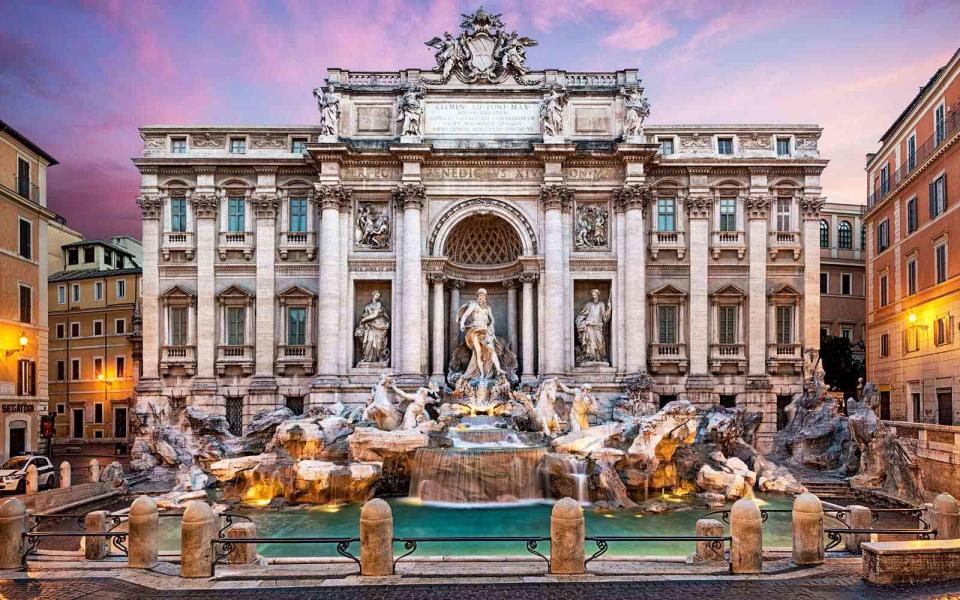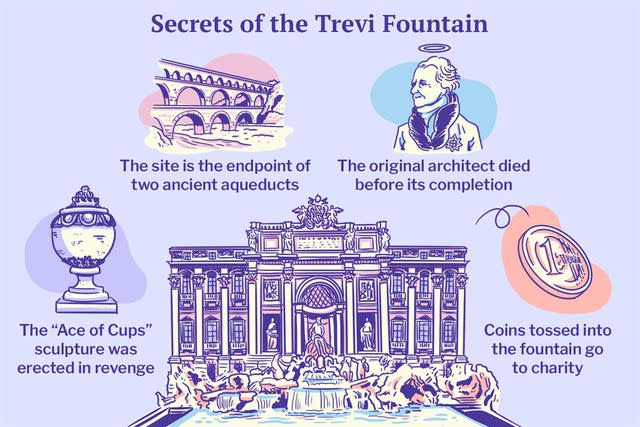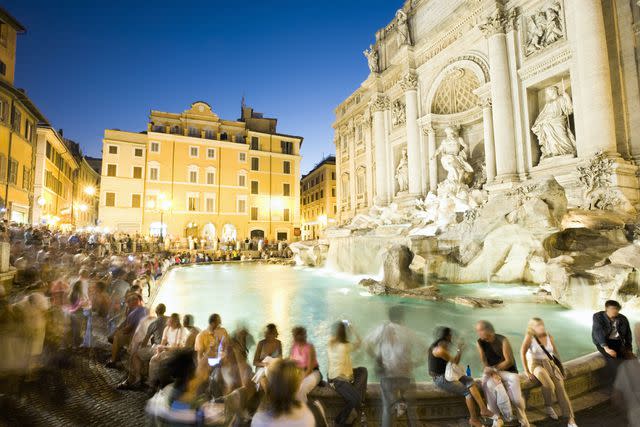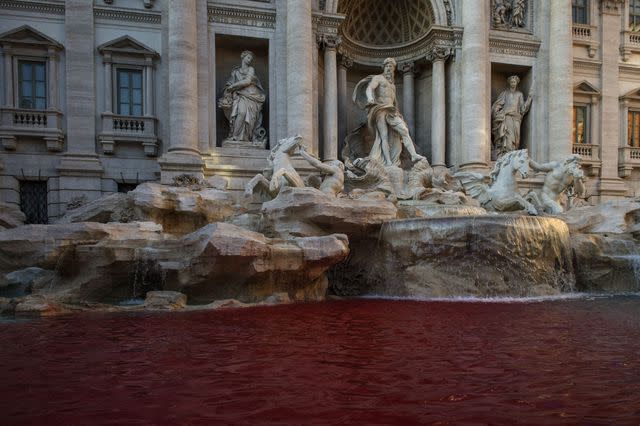10 Facts About Rome's Trevi Fountain
- Oops!Something went wrong.Please try again later.
Secrets of the iconic fountain's past include an architect's revenge on a local barber.

Rome, Italy, is undeniably a city steeped in history, with one foot in its ancient past and the other in the modern day. From the Colosseum to the Forum, the glory of the height of the Roman Empire can still be felt throughout. Yet, more recent landmarks draw an equal number of onlookers in this tourist-filled city.
The Trevi Fountain, built in the 1700s, is perhaps one of Rome's most iconic structures. Erected on the site of an ancient Roman water source, the fountain is made of the same material as the Colosseum (travertine stone).
The Trevi Fountain serves as a modern marvel that links back to Rome's fabled past. Here are a few peculiar facts and legends you probably don't know about the attraction.

Joshua Seong/Travel+Leisure
The fountain site is one of Rome’s oldest water sources.
The Trevi Fountain lies at the convergence of three roads (tre vie, in Italian, from which its name is derived) and is the endpoint of an ancient aqueduct, Aqua Virgo.
Constructed in 19 BCE, the aqueduct is said to have been named for a beautiful virgin who led thirsty soldiers to a spring that once existed at the very same spot. The aqueduct provided a vital source of water for the bustling center of Rome and its many public baths.
The sea god in the center is not who you think it is.
One would expect the god at the centerpiece of the Trevi Fountain to be Neptune, of course, the god of freshwater in the Roman religion. That god, however, turns out to be the Greek sea god Oceanus; you can tell by the way he's flanked by seahorses and mermen. The statues represent the different characteristics of rivers and seas.
The original architect died before its completion.
Much like the Sagrada Família church in Barcelona, the original architect of the Trevi Fountain, Nicola Salvi, died before getting the chance to see his plan come to fruition.
In 1730, when Pope Clement XII ordered a competition to find an architect for the fountain, Salvi lost to competitor Alessandro Galilei. However, the citizens of Rome decried the fact that a Florentine had won, and ultimately the project's commission went to Salvi. Construction began in 1732, and Salvi died in 1751. Following his death, sculptor Pietro Bracci oversaw the progress until its completion in 1762.
The “Ace of Cups" sculpture was built for revenge.
It is said that during the fountain's construction, a local barber was constantly annoyed by the noise and debris. Day in and day out, he'd pester Salvi with his dismay. Spitefully, Salvi erected the "Ace of Cups" sculpture at the left of the fountain so that the barber would never have a view of the masterpiece once it was completed.

The Trevi Fountain appears in some famous films.
You may recognize the Trevi Fountain if you've seen Fellini's "La Dolce Vita" (1960), "Three Coins in the Fountain" (1954), or "Roman Holiday" (1953) starring Audrey Hepburn. More recently, it appeared in "The Lizzie McGuire Movie" (2003).
In addition to movie cameos, the landmark has also been documented in literature like "The Marble Faun" by Nathaniel Hawthorne and in musical pieces like "Fountains of Rome" by Ottorino Respighi.
It's been a victim of vandalism.
In both 2007 and 2017, the Italian activist Graziano Cecchini dyed the water in the Trevi Fountain red in protest of corruption in Rome. According to reports at the times of the incidents, Cecchini had no intention of damaging the landmark permanently — and the stunt didn't, of course. Both times, the fountain was quickly drained before the precious stone was able to absorb the stain.
Coins tossed in the fountain go directly to charity.
The movie "Three Coins in the Fountain" established the tradition of tossing spare change into the Trevi Fountain. Legend has it that one coin thrown with the right hand over the left shoulder will guarantee you a safe return to Rome in the future, while a second coin will have your return met with romance. A third guarantees a Roman wedding.
Wishes aside, since 2006, a Roman Catholic charity called Caritas has collected the roughly €3,000 a day thrown into the fountain and used it to provide food and social programs worldwide.

The fountain underwent emergency repair after parts of it began to crumble.
In 2012, after a harsh winter, pieces of cornice began to fall from the historic fountain, creating an immediate need for restoration. Two years later, in June 2014, the fountain was shut off, drained, and cloaked in scaffolding for what would be 17 months. To carry on the tradition of coin-throwing, a basin was added to its base during renovations. In November 2015, €2.2 million worth of renovations were revealed and the Trevi Fountain's emerald waters finally returned.
It pumps out more water per day than one American uses in a lifetime.
According to Margaret Varnell Clark's 2013 guidebook, "Walking Through Rome," the Trevi Fountain pumps out about more than 2.8 million cubic feet of water daily. Based on the U.S. Environmental Protection Agency's estimates of how much water the average American uses in the household (82 gallons per day), it would take 697 years for one person to get through the amount of water pouring through Rome's landmark over a 24-hour period. (Don't worry, the water is recycled.)
Swimming in the Trevi Fountain will cost you €450.
It may be tempting to take a dip in the refreshing fountain on a sweltering summer day, but authorities have a zero-tolerance policy for swimming in the Trevi. According to one TripAdvisor user who tried it, "the police will wait for you [and] ask for your documents and will fine you the juicy amount of €450." Despite the user's no-regrets attitude about the costly dip — "it's totally worth it," they say — breaching the fountain could compromise the integrity of this stunning treasure, so choose to cool off in your hotel's pool instead.
For more Travel & Leisure news, make sure to sign up for our newsletter!
Read the original article on Travel & Leisure.

